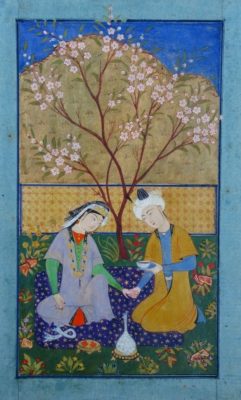
A special event in collaboration with Adam Williamson from Art of Islamic Pattern.
Paradise gardens is an introduction to the basics of Persian miniature painting. Learn to paint a small Cyprus tree and practice using miniature techniques. Through a series of practical demonstrations students will learn the methodology behind Persian Miniature painting.
By the end of the course, you will have a basic, practical understanding of how natural elements are drawn, and painted using traditional techniques.
Your contribution towards this class will allow you to stream a ZOOM RECORDING of this class.PLEASE NOTE:In this recording you I recommend using 'Cerulean blue' for the background. Whilst this is an excellent blue for mixing and creating many colours, it can be a bit harsh and synthetic looking when used on its own. I had to use it in this instance as many participants did not have access to other colours. I would recommend using indigo & lots of white instead!
In the Introductory series, there is no video demonstrating how to prepare the flour glue/size. This is because the sizing/gluing is a single class activity in itself. The intention of the Introductory series is to allow you to try the language and techniques used, to see if Miniature painting is a subject you enjoy. If you find yourself falling in love with the technique then you can move on and explore paper sizing, pigments etc in the second unit.
It is always recommended that you size your paper, as this seals pores and reduces warping, however, for your first and/or for a study in Miniature painting, you can ''get away'' with not sizing if using high quality, hot-pressed (smooth not textured) watercolour paper of about 300gsm (or more).

Painting completed by Marika Joubert @beautifultinythings.
Course Details:
Paradise Gardens
Location?
Online - Zoom
Questions?
Please email: info@yasminhayat.com
Suggested contributions of £5, £10, £15 and £20 allow me to continue these classes.
The course will require you to download the free app Zoom
REQUIRED equipment & materials:
Everything you need can be found in the painting kit linked here.
For Beginners:
- Cowrie Shell burnisher: linked one here,
- Handover brushes series 33 (or any other good quality, Kolinsky sable watercolour brush) in sizes 00, 1, 2 and 6/8.
-
00 Brush linked here
Size 1 Brush linked here
Size 2 Brush linked here
Size 8 Brush linked here - A ceramic palette with large wells (linked here) or an old ceramic porcelain/china dinner plate
- 2B, HB and H pencil (0.3 if using mechanical)
- Tracing paper (A4 or 27 × 11.69 inches) linked here
- Ruling pen (optional) linked here
- Masking tape, linked here.
- Compass or geometry kit. For UK, please click here, For US, please click here
- Ruler, linked here
- Eraser / mono-eraser, linked here
- 300gsm hot pressed water colour paper, in A4 or A3, Linked here.
- A4 (8.27 x 11.69 inches) or larger drawing board or hardback book. (A drafting table can be used.)
- Templates (received in email closer to the course date)
- Kitchen towel or old dish cloth
-
Gouache in the following recommended colours:
– Indigo (Beginners indigo, click here. For recommended - click here)
– Ultramarine. (Beginners Ultramarine, click here. For recommended - click here)
– Cadmium or Lemon yellow (Beginners Lemon yellow, click here. For recommended - click here)
– Yellow Ochre, click here
– Alizarin Crimson, click here.
– Vermillion or Cadmium Red. (Beginners Vermillion, click here. For recommended - click here)
– Titanium or Zinc white. (For titanium click here. For zinc - click here)
– Black (lamp black or ivory black) click here
– Burnt umber or Red ochre or Sepia, click here
– Oxide of Chromium* (click here)
- Watercolour set* (Generic, Ideally tubes. Linked here)
For more experienced students:
- For paper burnishing, I'd recommend this burnisher or for larger paper, this burnisher.
- For gold work, or burnishing small details, I'd recommend this burnisher
- Readymade, or hand-made gold
- For a small pan, click here
- For medium, click here
- For large, click here
Who is this course for?
All levels of experience and ability welcome.
Is there any preparation?
All participants will receive an email prior to the workshop if preparation is required
What should I wear?
Wear comfortable clothing that you do not mind getting slightly messy. Avoid wearing: Baggy clothing (especially sleeves) and Loose jewellery.
What about natural pigments?
Due to the long preparation, difficult accessibility and toxicity of some natural pigments, we will be using easily attainable, ready-made alternatives for this workshop. Traditional miniatures are compelled using paints derived from minerals, earths and insects. You will be able to achieve a similar result and finish using the recommended colours in the materials list.
Artwork featured is by the following students:
Haneefah Usmani @haneefahusmani
Laura Hayward.
Kamille Corry @kamillecorry
Marika Joubert @beautifultinythings
Lieve Oudejans. @artbylieveoudejans.















